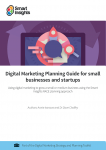6 Ways to launch and grow your startup using content marketing
Launching a start-up can be an exhilarating experience. However, there’s a difference between launching a startup and being able to grow a startup so that it becomes a long-term success. After all, there’s a reason why many startups tend to fail within a few years.
If it was so easy to successfully run a startup, everyone would be doing it. Oftentimes what happens is that when a startup is launched, its founders tend to get overzealous with their efforts to monetize its products and services, while failing to build a solid foundation from which the startup can actually be a viable company in the future.
While running a startup presents many unique challenges, the reality is that its growth starts with one thing: building an audience or user base.
If this remains the focus (assuming that the service or product that the startup offers is also up-to-par), success will surely follow.
So what exactly are the best ways to launch and grow a startup? In this writer’s opinion, there’s no better model to follow than the Content Inc. model by Joe Pulizzi, who is known as the “Godfather of Content” by many. Here are the six main steps of the Content Inc. model:
1. Figure Out Your “Sweet Spot”
First and foremost, it’s important to figure out your “sweet spot.” If you’re confused as to what I mean by that, the sweet spot is where your knowledge and skill expertise intersects with your genuine passion for a subject. It means truly having a passion for the industry or subject matter, along with in-depth knowledge and/or skill within it. Of course, this is easier said than done, but the truth is that you need to love what you do and be damn good at it as well.
Assuming that you haven’t found your sweet spot yet, one of the best ways to go about finding it, according to the Content Inc. model, is to create a list of your:
- Knowledge Areas/Special Skills
- Passions
Don’t start thinking about where there’s a gap in the market or what you can do to solve a problem for customers. Instead, jot down every area in which you have in-depth unique knowledge and/or special skills in. You need to find out what your authority area is. Once you do, you then need to see where your genuine passion lies at. For example, if you have exceptional coding skills, and your passion is in cooking, you might want to consider ways in which you can merge the two, such as by creating a unique cooking app.
2. Discover Your Content Tilt
Your content tilt is what makes your own approach to the particular niche or area that you’re going to business in different from everyone else’s. Find a particular area that there’s an opportunity in and a gap in products or services. You don’t want to enter an over-saturated market, but instead, to find a niche that is underserved.
Once you do discover what your content tilt is, it’ll be time to strike directly where there’s minimal competition so that you can gain first mover advantage and market share and make an impact. Stand out from everyone else and don’t blend in!
According to the Content Inc. model, some of the best ways to discover your content tilt is to:
- Create a mission statement
- Research customer needs
- Analyze industry trends
- Gain feedback from customers
- Always use analytics
Take your time and don’t rush the process.
3. Focus on Building Your Base
The third step in the process of launching and growing a startup is to focus on building your base. This means defining what your target audience is and then figuring out the best way to market to them.
The four parts of building your base according to Content Inc. are:
- The Type of Content
- The Platform of the Content
- Consistent Updates or Engagement
- Time to Build the Base
In online content marketing, it’s important to build up as large of a subscriber base or as many social media followers as possible. Your audience is the key component to growth in both the short-term and long-term. Once you build your base to a certain level, you’ll have the opportunity to grow your revenue.
4. Begin to Convert and Harvest Your Audience
After you have your product and service on an online platform and have built your base, you need to also remember to grow your subscriber/follower rate. One-time visitors to the medium that you have chosen should become subscribers. This will allow you to grow your subscriber list so that you can market products directly to them, as they’ll be the most likely to give you high conversion rates.
The best way to do this is to leverage social media and to focus on SEO. Remember, even if you are able to attract a high amount of web traffic, it’ll all be for nothing if you can’t also get the visitors to opt-in to your content.
5. Diversify From Your Core Platform
After you have been able to build up your audience from your core platform channel, it’s then time to expand and not rest on your laurels. You can do this by expanding into different delivery channels by which you hope to attract and maintain an audience.
This means not only having a successful landing page, but also expanding into every one of the main social media platforms, such as Facebook, Instagram, and Twitter. Not only will you put your brand in front of more eyes, but you can gain stronger loyalty and engagement from your current audience, as they’ll have multiple options through which they can engage with you.
6. Begin to Monetize Your Audience
The final step of the process of launching and growing your startup is focused on monetizing your audience. If you’ve followed the previous 5 steps correctly, you should by now have decided what your sweet spot is, found your content tilt, built your base and subscribers, and are on multiple platforms. It’s now time to reap the rewards.
The key way to monetize your audience is to see what works and what doesn’t work. You already have the subscriber count, so begin to analyze the quantitative and qualitative data and make adjustments when needed and see where there are opportunities to begin converting your audience into being paying customers. Be willing to adapt and to follow the path of interest that the audience analytics dictates.
Conclusion
Since the vast majority of startups fail within their first two years, do you really want to keep following the same outdated rules that other unsuccessful startup founders did? Joe Pulizzi, through Content Inc., has crafted a proven, modern approach to growing your business as an online startup through these six steps.
When it comes down to it, it’s actually a simple process to follow. Just make sure to offer something that’s valuable and fills in a market gap, build your audience around it, and then monetize it. With attention spans shorter than ever and there being a growing number of options that are all vying for the attention of consumers, it makes sense to build your audience first and only then to focus on monetizing your product or service.
In the content-obsessed world that we live in today, this is the best path to long-term, sustainable growth for your startup. Good luck!

 Fatmir is the CMO of
Fatmir is the CMO of